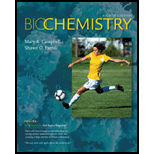
Concept explainers
RECALL What is the difference in the requirement for a primer in RNA transcription compared to
Interpretation:
The difference between the requirement of primer in RNA transcription and DNA replication is to be explained.
Concept introduction:
Primer is a short stretch of oligonucleotide needed for the initiation of DNA replication.
Primer is synthesized by the enzyme primase at the beginning of DNA replication.
Primase copies a small stretch of template DNA strand to produce an RNA primer.
The process of producing two identical copies of DNA molecule from original DNA molecule is called DNA replication.
The process of copying of DNA into a new molecule of mRNA is called transcription.
Answer to Problem 1RE
Solution: Primer is not required for the activity of RNA polymerase, the enzyme that carries out RNA transcription. However, DNA polymerases need an RNA primer during initiation step of DNA replication to be able to start the polymerization reaction.
Explanation of Solution
Given information: Primer, RNA transcription, and DNA replication
RNA transcription is carried out by an enzyme called RNA polymerase, which is a DNA-dependent polymerase that needs DNA as a template in order to synthesize RNA. Only one strand of DNA is used for transcription. The strand of DNA, which is read in the 3’ to 5’ direction by the RNA polymerase, is known as the template strand or antisense strand. The template DNA sequence, which signals the start of RNA transcription, is known as a promoter. RNA polymerase binds to the promoter sequence and synthesizes RNA using all four ribonucleoside triphosphates (ATP, GTP, UTP, and CTP). In the process of RNA synthesis, RNA polymerase does not require primer due to its ability to de novo synthesize RNA by positioning a ribonucleoside triphosphates (usually a purine) complementary to the template strand.
During replication, both the strands of DNA are required as template by DNA polymerase to synthesize the leading and lagging strand. DNA polymerase needs a free 3’- hydroxyl group already in place in order to synthesize the DNA chain. The RNA primer synthesized by the enzyme primase at the beginning of replication helps provide a free 3’- hydroxyl group for the initiation of DNA replication. In the absence of a primer, DNA polymerase cannot catalyze the DNA polymerization reaction. Once the DNA strands have been completely synthesized, primer is removed and replaced with deoxynucleotides by DNA polymerase I using the exonuclease and polymerase activity, respectively. DNA polymerases possess proof reading activity to check for any errors in the newly synthesized DNA strands. The presence of proofreading activity in DNA polymerase is compensated by the absence of primer synthesis ability, thereby making sure that DNA replication is an error proof process.
RNA polymerase can initiate a primer free transcription, whereas DNA polymerase needs primer to initiate the replication of DNA.
Want to see more full solutions like this?
Chapter 11 Solutions
Biochemistry
- What is the formation of glycosylated hemoglobin (the basis for the HbA1c test)? Can you describe it?arrow_forwardPlease analze the gel electrophoresis column of the VRK1 kinase (MW: 39.71 kDa). Also use a ruler to measure the length of the column in centimeters and calculate the MW of each band observed. Lane 1: buffer Lane 2 : Ladder Lane 3: Lysate Lane 4: Flowthrough Lane 5: Wash Lanes 6-8: E1, E2, E3 Lane 9: Dialyzed VRK1 Lane 10: LDHarrow_forwardDo sensory neurons express ACE2 or only neurolipin-1 receptors for COVID19 virus particle binding?arrow_forward
- Explain the process of CNS infiltration of COVID19 through sensory neurons from beginning to end, including processes like endocytosis, the different receptors/proteins that are involved, how they are transported and released, etc.,arrow_forwardH2C CH2 HC-COOO CH2 ܘHO-C-13c-O isocitrate C-S-COA H213c CH2 C-OO 13C-S-COA CH2 C-00 the label will not be present in succinyl CoA C-S-COA succinyl-CoAarrow_forwardA culture of kidneys cells contains all intermediates of the citric acid cycle. It is treated with an irreversible inhibitor of malate dehydrogenase, and then infused withglucose. Fill in the following list to account for the number of energy molecules that are formed from that one molecule of glucose in this situation. (NTP = nucleotidetriphosphate, e.g., ATP or GTP)Net number of NTP:Net number of NADH:Net number of FADH2:arrow_forward
- 16. Which one of the compounds below is the final product of the reaction sequence shown here? OH A B NaOH Zn/Hg aldol condensation heat aq. HCI acetone C 0 D Earrow_forward2. Which one of the following alkenes undergoes the least exothermic hydrogenation upon treatment with H₂/Pd? A B C D Earrow_forward6. What is the IUPAC name of the following compound? A) (Z)-3,5,6-trimethyl-3,5-heptadiene B) (E)-2,3,5-trimethyl-1,4-heptadiene C) (E)-5-ethyl-2,3-dimethyl-1,5-hexadiene D) (Z)-5-ethyl-2,3-dimethyl-1,5-hexadiene E) (Z)-2,3,5-trimethyl-1,4-heptadienearrow_forward
- Consider the reaction shown. CH2OH Ex. CH2 -OH CH2- Dihydroxyacetone phosphate glyceraldehyde 3-phosphate The standard free-energy change (AG) for this reaction is 7.53 kJ mol-¹. Calculate the free-energy change (AG) for this reaction at 298 K when [dihydroxyacetone phosphate] = 0.100 M and [glyceraldehyde 3-phosphate] = 0.00300 M. AG= kJ mol-1arrow_forwardIf the pH of gastric juice is 1.6, what is the amount of energy (AG) required for the transport of hydrogen ions from a cell (internal pH of 7.4) into the stomach lumen? Assume that the membrane potential across this membrane is -70.0 mV and the temperature is 37 °C. AG= kJ mol-1arrow_forwardConsider the fatty acid structure shown. Which of the designations are accurate for this fatty acid? 17:2 (48.11) 18:2(A9.12) cis, cis-A8, A¹¹-octadecadienoate w-6 fatty acid 18:2(A6,9)arrow_forward
 BiochemistryBiochemistryISBN:9781305961135Author:Mary K. Campbell, Shawn O. Farrell, Owen M. McDougalPublisher:Cengage Learning
BiochemistryBiochemistryISBN:9781305961135Author:Mary K. Campbell, Shawn O. Farrell, Owen M. McDougalPublisher:Cengage Learning
